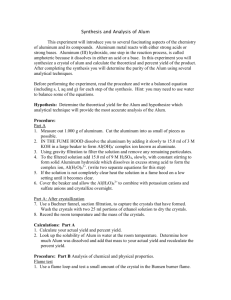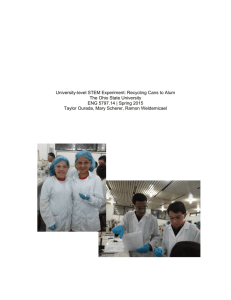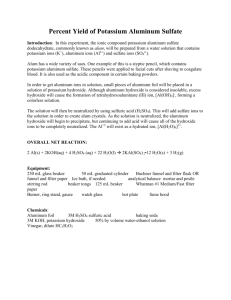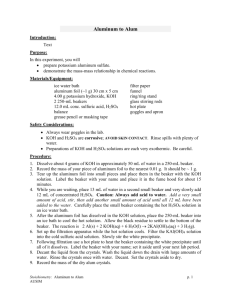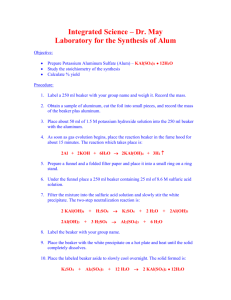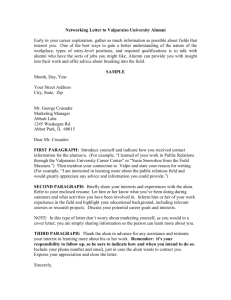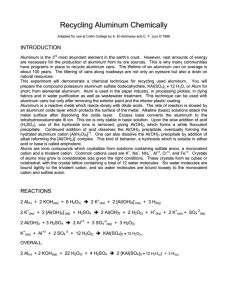Synthesis of Potassium Alum
advertisement
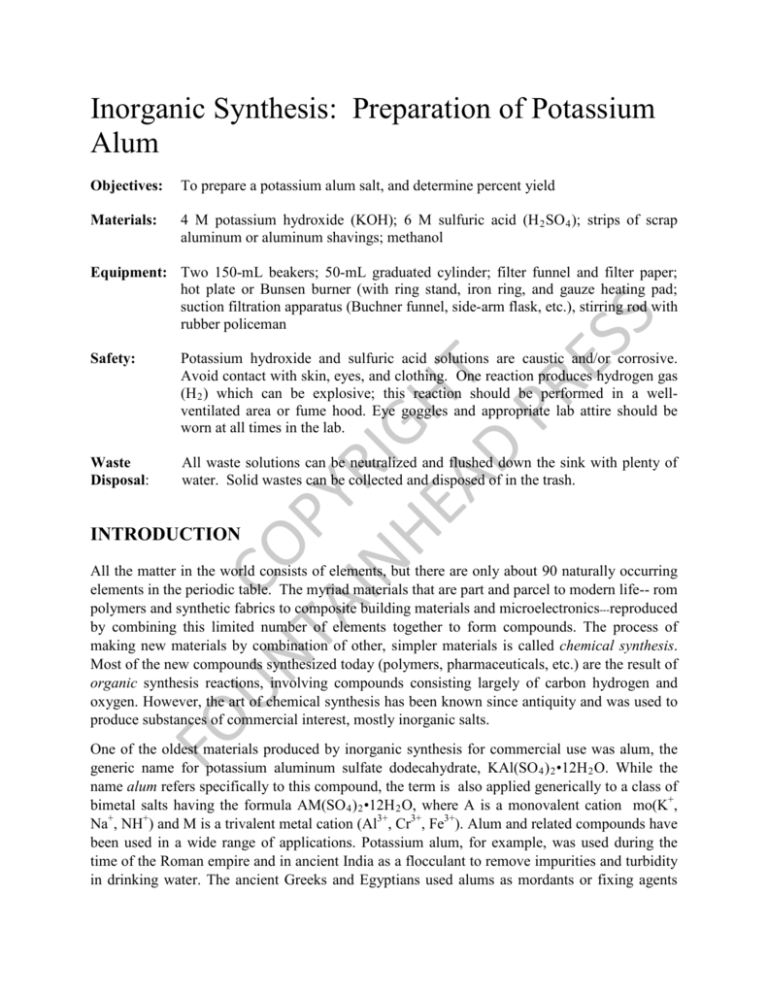
Inorganic Synthesis: Preparation of Potassium Alum Objectives: To prepare a potassium alum salt, and determine percent yield Materials: 4 M potassium hydroxide (KOH); 6 M sulfuric acid (H 2 SO 4 ); strips of scrap aluminum or aluminum shavings; methanol UN CO TA PY IN RIG HE H AD T PR ES S Equipment: Two 150-mL beakers; 50-mL graduated cylinder; filter funnel and filter paper; hot plate or Bunsen burner (with ring stand, iron ring, and gauze heating pad; suction filtration apparatus (Buchner funnel, side-arm flask, etc.), stirring rod with rubber policeman Safety: Potassium hydroxide and sulfuric acid solutions are caustic and/or corrosive. Avoid contact with skin, eyes, and clothing. One reaction produces hydrogen gas (H 2 ) which can be explosive; this reaction should be performed in a wellventilated area or fume hood. Eye goggles and appropriate lab attire should be worn at all times in the lab. Waste Disposal: All waste solutions can be neutralized and flushed down the sink with plenty of water. Solid wastes can be collected and disposed of in the trash. INTRODUCTION FO All the matter in the world consists of elements, but there are only about 90 naturally occurring elements in the periodic table. The myriad materials that are part and parcel to modern life-- rom polymers and synthetic fabrics to composite building materials and microelectronics---reproduced by combining this limited number of elements together to form compounds. The process of making new materials by combination of other, simpler materials is called chemical synthesis. Most of the new compounds synthesized today (polymers, pharmaceuticals, etc.) are the result of organic synthesis reactions, involving compounds consisting largely of carbon hydrogen and oxygen. However, the art of chemical synthesis has been known since antiquity and was used to produce substances of commercial interest, mostly inorganic salts. One of the oldest materials produced by inorganic synthesis for commercial use was alum, the generic name for potassium aluminum sulfate dodecahydrate, KAl(SO 4 ) 2 •12H 2 O. While the name alum refers specifically to this compound, the term is also applied generically to a class of bimetal salts having the formula AM(SO 4 ) 2 •12H 2 O, where A is a monovalent cation mo(K+, Na+, NH+) and M is a trivalent metal cation (Al3+, Cr3+, Fe3+). Alum and related compounds have been used in a wide range of applications. Potassium alum, for example, was used during the time of the Roman empire and in ancient India as a flocculant to remove impurities and turbidity in drinking water. The ancient Greeks and Egyptians used alums as mordants or fixing agents when dyeing fabrics. It is still used today in applications ranging from antiperspirants and baking powder to astringents and coagulants. In this lab activity we will synthesize potassium alum from aluminum metal. The synthesis is a multi-step process; first, aluminum metal dissolves by reaction with potassium hydroxide to form the aluminate complex ion: 2Al(s) + 2K+(aq) + 2OH-(aq) + 6H 2 O(l) 2K+(aq) + 2Al(OH) 4 - + 3H 2 (g) (1) This step can be classified as a redox reaction in which the Al is oxidized and the water is reduced to hydrogen gas. The next step in the synthesis involves an acid-base neutralization reaction. Sulfuric acid is added to neutralize the hydroxides in the aluminate ion and replace them with sulfate: UN CO TA PY IN RIG HE H AD T PR ES S K+(aq) + Al(OH) 4 - + 2H 2 SO 4 (aq) K+(aq) + Al(SO 4 ) 2 - + 4H 2 O(l) (2) FO When the solution containing the product in Reaction (2) is cooled, the final product crystallizes from solution in proportions consistent with potassium alum, KAl(SO 4 ) 2 •12H 2 O. Pre-Lab Questions 1. One of the preliminary products in the synthesis of alum is aluminum hydroxide, Al(OH) 3 . This substance is amphoteric, meaning that it reacts with both acids and bases to dissolve in an aqueous solution. Write balanced chemical reactions for each of the following: UN CO TA PY IN RIG HE H AD T PR ES S a. Reaction of solid aluminum hydroxide with hydrochloric acid to form aluminum chloride. b. Reaction of solid aluminum hydroxide with potassium hydroxide to form the aluminate complex ion. One of the steps in this procedure is performed in a well-ventilated area, preferably a fume hood. Why? Write a balanced chemical equation to illustrate. 3. Alum compounds are used in a variety of applications, some of which are discussed in the lab Introduction. Perform a literature or web search to identify another application or use of an alum salt not specifically discussed in the Introduction. FO 2. PROCEDURE 1. Obtain a clean 150-mL beaker and weigh it using an analytical balance. Record the mass of the beaker on the Data Sheet to the nearest 0.01 g. 2. Obtain a sample of scrap aluminum metal (cut into small pieces) or aluminum turnings. Transfer about 1.0 g of the sample to the 150-mL beaker and record the mass of beaker + sample on your Data Sheet to the nearest 0.01 g. Be sure to use the same balance as you used to weigh the beaker in Step 1. UN CO TA PY IN RIG HE H AD T PR ES S 3. Using the 50-mL graduated cylinder, measure about 25 mL of 4M potassium hydroxide (KOH) and add it to the beaker. 4. Move the beaker to a well-ventilated area, preferable a fume hood. Using either a hot plate or a Bunsen burner, heat the beaker gently to initiate the reaction, which will be evident when the mixture starts to fizz as hydrogen gas is evolved. Take care not to heat too vigorously, as this may result in the overheating and splattering of the KOH solution. (KOH is caustic!) 5. Continue gently heating until the aluminum sample is completely dissolved. The entire process may take 20--30 minutes, depending on the rate of heating and the size of the pieces of Al metal. Monitor the volume of the reaction solution and add DI water to maintain the solution volume at a level between 12--18 mL. When the reaction is complete, remove the beaker from the heat. 6. Carefully filter the warm solution using a glass filter funnel and filter paper to collect any insoluble impurities. Using a glass rod as a guide, pour the solution into the filter funnel as illustrated in Figure 1. 7. Collect the clear filtrate in another clean 150-mL beaker. Allow the solution to cool. FO 8. Obtain about 20 mL of 6 M H 2 SO 4 in a 50-mL graduated cylinder. Slowly add small increments of the H 2 SO 4 to the reaction solution while stirring. Continue adding small increments until a white, insoluble solid (Al(OH) 3 ) starts to form. This should occur after the addition of ~15--18 mL of H 2 SO 4 . 9. Gently heat the solution while stirring until any solid Al(OH) 3 has dissolved. At this point the solution should be clear; any undissolved impurities can be removed by filtration using the same procedure as discussed in Step 6. Figure 1. Gravity filtration apparatus 10. Cool the reaction solution in an ice bath for about 20--30 minutes, at which point alum crystals should have formed. If no crystals are evident, reheat the solution until the total volume has decreased to half the original volume (10--12 mL). Cool the solution until alum crystals have formed. UN CO TA PY IN RIG HE H AD T PR ES S 11. Use a vacuum filtration system, illustrated in Figure 2, to collect the alum crystals. Decant the supernatant from the beaker using a glass rod, in a similar fashion as in Step 6. Using a rubber policeman, transfer as much of the alum product to the vacuum filter as possible. 12. Add about 5 mL of cold methanol to the 150-mL beaker to rinse any uncollected crystals, and transfer to the vacuum filter. Wash the collected crystals with another 5-mL of cold methanol. Maintain suction filtration until the crystals are dry. Figure 2. Vacuum filtration apparatus with Buchner funnel. FO 13. Weigh a clean, dry watch glass and record the mass on the Data Sheet to the nearest 0.01 g. Transfer the alum crystals to the watch glass and reweigh, recording the mass on the Data Sheet. Calculate the mass of product, by difference, and record on the Data Sheet to the appropriate level of precision. CALCULATIONS 1. Calculate the initial mass of aluminum metal (by difference) and record on the Data Sheet to the nearest 0.01 g. 2. Calculate the mass of alum product (by difference) and record on your Data Sheet to the nearest 0.01 g. 3. Based on the initial mass of the aluminum sample and the stoichiometry of the reactions (Equations 1 and 2), calculate the theoretical yield of alum; record this on your Data Sheet. UN CO TA PY IN RIG HE H AD T PR ES S 4. Calculate the percent yield for your reaction as: % 𝑦𝑦𝑦𝑦𝑦𝑦𝑦𝑦𝑦𝑦 = 𝐴𝐴𝐴𝐴𝐴𝐴𝐴𝐴𝐴𝐴𝐴𝐴 𝑦𝑦𝑦𝑦𝑦𝑦𝑦𝑦𝑦𝑦 (𝑚𝑚𝑚𝑚𝑚𝑚𝑚𝑚 𝑜𝑜𝑜𝑜 𝑝𝑝𝑝𝑝𝑝𝑝𝑝𝑝𝑝𝑝𝑝𝑝𝑝𝑝) 𝑇𝑇ℎ𝑒𝑒𝑒𝑒𝑒𝑒𝑒𝑒𝑒𝑒𝑒𝑒𝑒𝑒𝑒𝑒𝑒𝑒 𝑦𝑦𝑦𝑦𝑦𝑦𝑦𝑦𝑦𝑦 FO Record the % yield on your Data Sheet. × 100 (x) Data Sheet I. Mass of initial Al Sample _________________ Mass of beaker (empty) (g) _________________ Mass of sample (g)* _________________ UN CO TA PY IN RIG HE H AD T PR ES S Mass of beaker + sample (g) *(determined as the difference of prior mass measurements.) II. Mass of Alum Product Mass of watch glass + sample (g) _________________ Mass of watch glass (empty) (g) _________________ Mass of alum product (g)* _________________ III. Percent Yield Theoretical yield: __________________________(g) Actual yield (from II): _______________________(g) FO % Yield ( Eq. (x)): ________________________ Post-Lab Questions Alums are hydrated salts, meaning that water molecules are incorporated into the crystal lattice structure for the salt. Calculate the % by mass of water in the alum product for this lab. 2. Based on the synthesis reactions summarized in the Introduction, calculate the expected theoretical yield of potassium aluminum sulfate dodecahydrate (potassium alum) that would be obtained from reaction of 1.024 g of scrap aluminum. 3. For each of the circumstances described below, discuss how it might affect the calculated % yield (i.e., increase or decrease) and briefly explain why. UN CO TA PY IN RIG HE H AD T PR ES S 1. (a) A student does not filter the solution before proceeding to reaction with H 2 SO 4 . FO (b) A student washes the alum crystals with 25 mL of methanol mixture instead of the recommended 5--10 mL. (c) In order to dry the alum product faster to obtain a final mass, the student heated the beaker containing the solid on a hot plate for 20 minutes.

